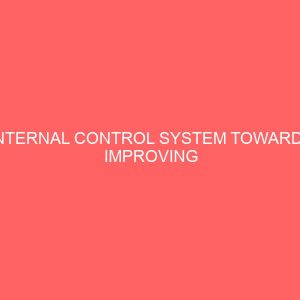Description
CHAAPTER ONE
INTRODUCTION
1.1 BACKGROUND OF THE STUDY
Borno State is one of the North Eastern State in Nigeria with its capital in Maiduguri created in 1976. The state has a population growth rate of about 3.0%, with a current population estimated at about 4.5 million (2006 census). The children under five are estimated at about 907,224 (20% of the total population).The main economic activities of the people are farming and fishing living below the poverty level. The mortality indices in Borno state is regarded as one of the worst in the country. Estimate shows that Infant Mortality stands at 109/1000LB1 while under five Mortality is estimated at 222/1000LB1. The Maternal Mortality ratio is taken as 545/100000LB2. Health facility Within the Health Sector consist of 1 fully equipped Hospital with a combined bed capacity of 3430 beds, 32 General Hospitals, and 1 Specialized Hospital other health facility consist of federal institutions located in Maiduguri. This includes Neuropsychiatry Hospital, 100-bed capacity and the Police Hospital, 30 bed capacities. The University of Maiduguri Teaching Hospital has 1000-bed capacity. There are also about 449 PHC facilities owned by LGAs which include 48 health center,140 health clinics,195 Dispensaries and health post ,34 maternal and child clinics , 36 private health clinics and 3
Missionary/NGO owned clinics. The major factor hindering effective health care delivery include among others Inadequate Human Resources which result to lack of efficient coordination of health intervention program in the state .BORNO STATE GOVERNMENT STRATEGIC HEALTH DEVELOPMENT PLAN (2010-2015)
. Consequently the research seeks to investigate the effect of personnel management on the performance of the health sector in Borno state.
1.2 STATEMENT OF THE PROBLEM
The Borno State Government had embarked on the construction and rehabilitation of health facilities in the state .This is in line with its objective of providing increase access to healthcare for its citizens. However, conscious effort must be made through effective planning to achieve its health care delivery objective. Consequently, the challenges of human resources would therefore need to be addressed .Currently available records indicate the inadequacy of
Human Resources needed for the realization of the effective for Health care delivery in the state. The Borno state health records shows that key health personnel under the state public service consist of 235 Community Health Officers, about 1236 nurses & midwives,74 doctors, 13 pharmacists, 18 medical lab scientists . These human resource statistics reveals the gross insufficiency of health care personnel required to achieve the needed effective health care delivery for the about 4.5m state population .and forms part. The situation reveals that many health care facilities do not have Doctors, sufficient nurses and midwives, pharmacist and or medical lab scientist. Apparently many of this health care facilities do not have
adequate and the right mix of human resources for effective health care delivery especially, at the middle-level and providing health care to the rural population is obscured due to lack and insufficient health personnel required to effectively provide primary healthcare services .
Therefore the greatest challenge for the Borno state government is to address this
Imbalance, in a systematic manner and on a sustained basis. Consequently the strategic plan of the Borno state government is to increase the level of the workforce on an annual basis from the present level of 10% which is below 25% by WHO standard to the level of 60% by 2015. This precipate the need for the evolution of the plan to recruit new health personnel to fill in the gaps for critical health personnel in the state which will include doctors, community health officers pharmacists, midwives and nurses and significantly, a general staff re-training and
Re-orientation exercise aimed improving the state of all health workers in the state. BORNO STATE GOVERNMENT STRATEGIC HEALTH DEVELOPMENT PLAN (2010-2015)
Consequently the problem confronting the research is to appraise the Effect of personnel management on the performance of health sector in borno state.
1.3 OBJECTIVES OF THE STUDY
The objective of the study is to determine the effect of personnel management on the performance of health sector in Borno state.
1.4 RESEARCH QUESTIONS
What is the level of impact of personnel management on the health sector in Borno state
1.5 SIGNIFICANCE OF THE STUDY
The study shall elucidate on the state of the health sector in borno state and proffer the impact of personnel management on the health sector in Borno state.
1.6 RESEARCH HYPOTHESIS
Ho The effect of personnel management on the health sector in Borno state is Low
Hi The effect of personnel management on the health sector in Borno state is High
1.7 SCOPE OF THE STUDY
The study focuses on the appraisal of the effect of personnel management on the health sector in Borno state.
1.8 LIMITATIONS OF THE STUDY
The research was confronted with logistics constraint and also bearing in mind geographical factor.
1.9 DEFINITION OF TERMS
HEALTH DEFINED
Health is defined as the condition of being sound in body, mind, or spirit
PERSONNEL MANAGEMENT DEFINED
Personnel management is defined as the Administrative discipline of hiring and developing employees conducting job analyses, planning personnel needs and recruitment selecting the right people for the job, orienting and training, determining and managing wages and salaries, providing benefits and incentives, appraising performance resolving disputes, communicating with all employees at all levels so as to develop and sustain an effective and valuable work force.
MORTALITY RATE
Mortality rate, otherwise known as death rate is the determination of the number of deaths per population for a given period of time. Mortality rate is usually stated in units of deaths per 1,000 persons per year; consequently, a mortality rate of 9.5 of 1,000 in a population of 1,000 would mean 9.5 deaths per year in that entire population, or 0.95% out of the total. This is different from ”morbidity” which constitute the prevalence or incidence of a disease, and the incidence rate indicating the number of newly cases of the disease per unit of time.







